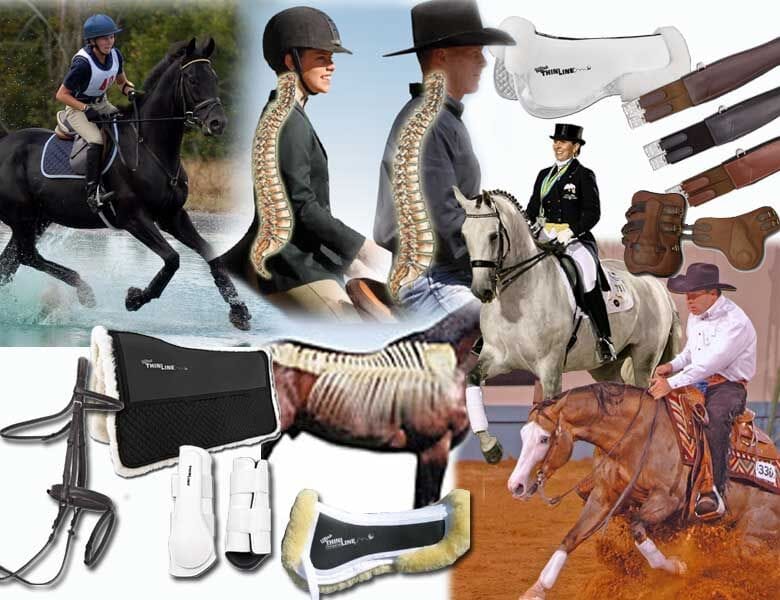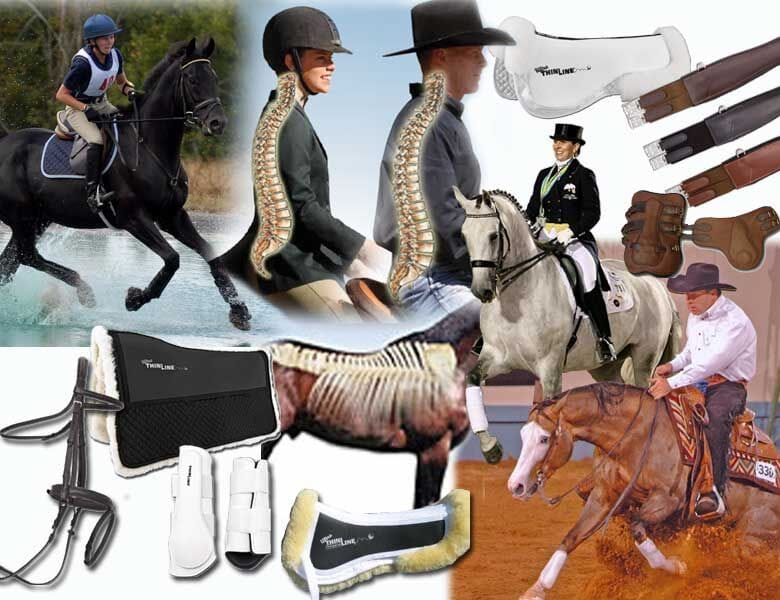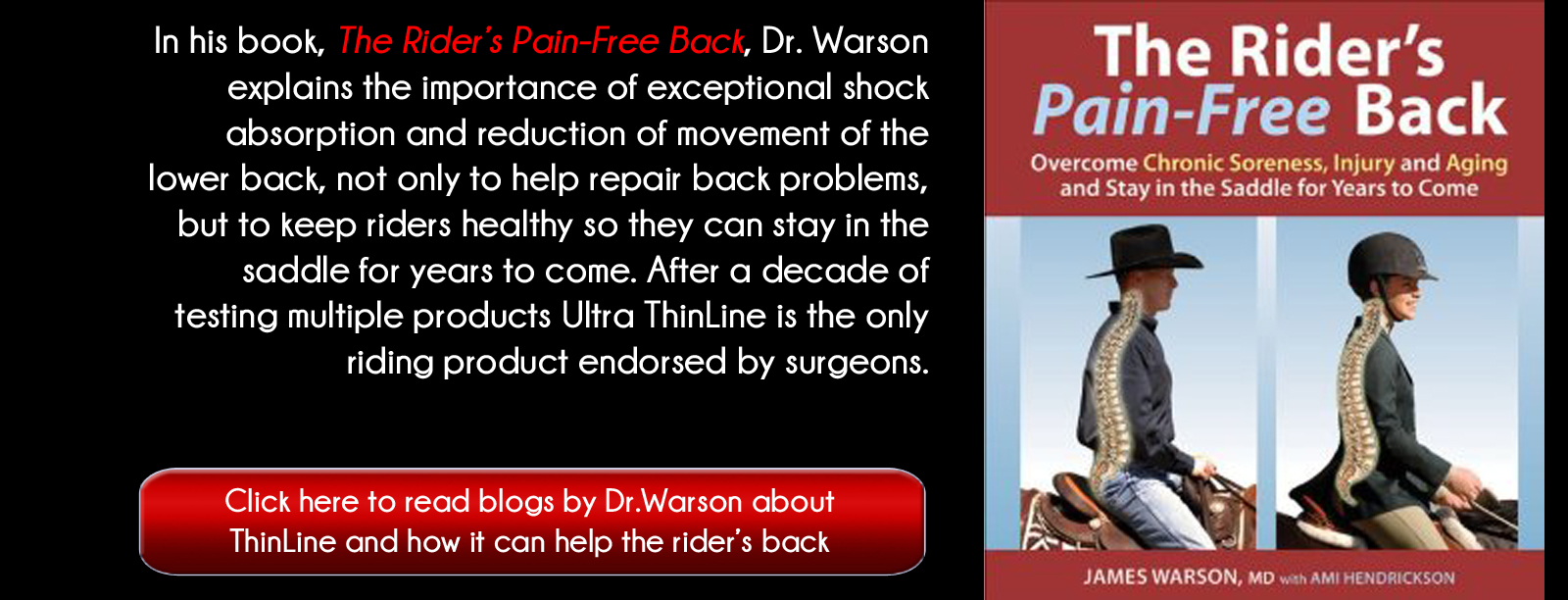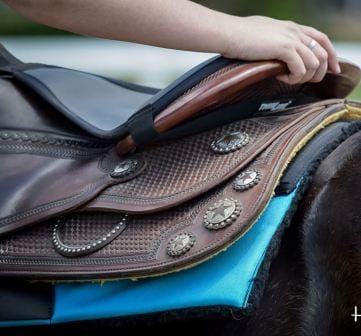ThinLine is creating products that promote healthy backs for horses and riders.
When we think of horseback rider injuries, we typically think of a fall or some other traumatic event. What we often don’t think about is the concussive damage that riding can produce to the rider’s spine. While, you’ll see hundreds of products, from helmets to safety stirrups to air vests, that were designed to help prevent or minimize the damage from a fall, you won’t see many products focusing on the rider’s health while still in the saddle (a place where most riders like to stay). ThinLine products, however, are focusing on both the rider and the horse.
What makes backs hurt?
Every fitness venue has a component of long-term wear someplace in the body. For example, running is typically hard on the tendons and knees. For riders, it is the compression of the spine over time. In order to minimize these injuries, we must first look at what causes them.
Research suggests that how you ride and your level of fitness can contribute to lower back pain injuries in horseback riders. For instance, ridings in shorter stirrups, as well as a lack of core strength, are associated with lower back pain. Horseback riding is an excellent way to stay fit – for mind, body, and soul – but like any sport, too much too fast can cause injuries.
The challenge lies in discovering how to stabilize a rider enough to allow him/her to really work on their strength and stretch issues while in the saddle. This is part of why ThinLine developed the Seat Saver, which greatly reduces riders movement in the saddle. When you reduce movement, you will increase a riders ability to exercise and work the correct muscles needed for good riding, which in turn can reduce the effects on the lower back. Now add to this- shock absorption that the Seat Saver provides, and you can also minimize the concussive effects to the rider’s spine. While riders can feel and receive benefits from a ThinLine pad, where the horse is the focus of the comfort, the Seat Saver delivers more protection directly to the rider’s spine.
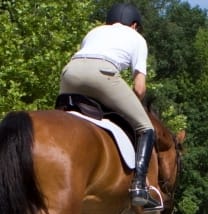
People are living and staying fit longer, meaning they are riding longer and “the Seat Saver will, if used as a safety product for the spine, extend and improve rider back health, keeping them in the saddle for years to come,” said Dr. James Warson, author of “The Riders Pain-Free Back”, Trafalgar Square Publishing”.
Improper saddle fit can cause back pain, too.
Many times, an ill-fitting saddle can also be the culprit for horse and rider back pain. A recent study found ill-fitting saddles are not only associated with back muscle asymmetry, a stilted gait and back pain in the horse but they are also associated with back pain in the rider.
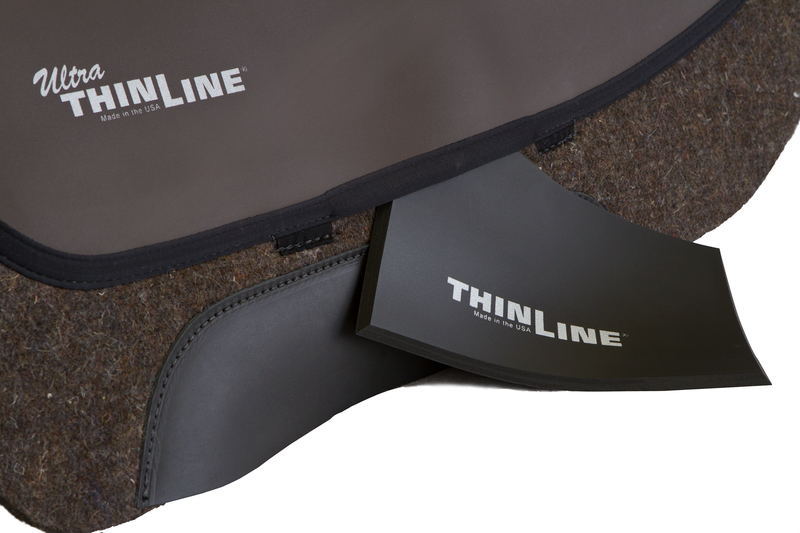
In the study of 205 riders, ill-fitting saddles were identified in 43% of the horses. Saddle slip was observed in 14.6% of horses, which was significantly associated with hind limb lameness or gait abnormalities. However, only two riders had linked saddle slip and lameness despite strong associations between a history of lameness, history of ‘back problems’ and history of saddle slip. Additionally, 38% of riders in the study had back pain that was associated with ill-fitting saddles. The study showed that rider back pain was also associated with rider crookedness.
“Ideally saddle fit should be checked more often than once a year to reduce the instances of ill-fitting saddles,” said Line Greve, a researcher involved with the study. “Yet this isn’t the whole solution because worryingly, 30% of horses that had their saddles checked at least once yearly still had an ill-fitting saddle. What is unknown is whether these saddles had ever fitted correctly or whether a properly qualified saddle fitter was responsible for the fitting. It can only be of benefit for riders, trainers, and other associated professionals to become more educated about the complexity of the links between lameness, saddle slip, ill-fitting saddles and rider crookedness.”
Saddle fit also is critical in alleviating back pain when riding. “You don’t want to use a saddle made for a Thoroughbred on a Quarter Horse,” said James Warson, M.D., a horseman and now-retired physician who spent 20 years as a neurosurgeon and medical director at a Fort Collins, Colo., clinic.
To help make you and your horse comfortable, Warson recommends buying a custom saddle made to fit you and the horse. However, this can be expensive and even out of reach especially for riders who own multiple horses. As an alternative, he recommended getting a saddle fitter to fit the pad to the horse with shims, preferable ThinLine. ThinLine pads such as the Basic Pad can also reduce slippage, which has been proven to cause back problems in horses and riders.
Thicker isn’t always better
People just assumed the thickness would make their horses comfortable and reduce concussion. But that wasn’t the case. Those pads allowed the saddle to shift unnecessarily.
“They’re death to riders,” Warson explains, “Because they have yaw-side-ways motion.”
Warson recommends a ThinLine pad, which is a shock-absorbing the non-slip material.
“The pad’s about 3/8-inch thick, and it not only helps riders’ backs but also the horses’ backs,” he says.
Saddle type and balance can lead to back pain in riders
Another study of 108 equestrian riders, which was published in the British Journal of Sports Medicine, looked at the effects from two different saddle types (a general purpose saddle and a deep-seated Western saddle). The study showed that 66% of the riders who rode in the general-purpose saddle had lower back pain, while only 23% of those in the deep-seated saddle reported back pain.
The researchers concluded: “The difference in the incidence of lower back pain between the users of the two saddle types may be due to the additional comfort, cushioning, postural positioning, and stability offered by the design of the deep seated saddle. The results suggest that, while a deep seated saddle is not suited to all equestrian activities, where possible its use should be considered because of its effect in reducing the risk of lower back pain.”
This is another area where ThinLine’s Seat Saver can help reduce the effects on the rider’s back. The Seat Saver adds the right amount of cushion to the saddle without adding a lot of bulk. This allows the rider to have a more secure seat while riding and the ThinLine material reduces the concussion to the rider.
Tips to prevent back injuries in riders
Horseback rider injuries are a common occurrence, but it’s important to minimize the injuries as much as possible. Warson said exercise can help eliminate back pain. It’s important to stay fit and work all the areas of your body, including your hips, pelvis and thigh muscles. “Working on these areas is extremely important,” he stressed.
Balance is an important player in back health, too. Make sure that you are sitting properly in the saddle, and that your stirrups are adjusted correctly. Also, using a ThinLine Seat Saver can help you balance better in the saddle while reducing the concussion on your back.
Make sure that you have a well-fit saddle. Again, it might be difficult to do this if you ride several horses, or you just can’t justify the cost of a custom saddle. The next best thing is to use a ThinLine saddle pad that you can shim to make the proper adjustments. This will help your horse’s and your back be more comfortable while riding.
What others are saying about the ThinLine Seat Saver
“I purchased this pad to use on an old, very hard seat roping saddle that caused very bad lumbar back pain with each ride,” said Chelsea Petush. My riding was suffering because I was finding myself trying to do anything I could to ease the concussion on my back when I was riding my horse. So after reviewing several pads looking for one that wasn’t bulky, one that wouldn’t slip with maneuvers of roping events or barrel racing, and one that would ease the pain, I chose the ThinLine pad. When I received it in the mail my first thought was there was no way this would do anything to stop the concussion on my back when hitting a hard stop or working my horse… boy was I surprised the first time I used it! It was great, I hit a hard stop and braced for the “ouch”, but nothing! No pain, wow! This pad is awesome and to top it off you don’t even know it is there, no slipping, no bunching up it’s fantastic! I would recommend ThinLine products to anyone.”
About ThinLine
ThinLine’s saddle pads are made with shock-absorbing, breathable foam, which not only enhances riding but also improves saddle fit. Properties of the foam create harmony between rider and horse. ThinLine is the only product endorsed by Spinal Surgeons.
ThinLine products have a money back guarantee that you and your horse will see improved performance and communication. As with all ThinLine tack, our mission is to improve your riding pleasure, skill, and performance.
https://thinlineglobal.eu/shop/western-saddle-pads/western-saddle-seat-saver-shock-absorbing-comfort-riders-love
To view the entire ThinLine collection, visit thinlineglobal.eu. Follow us at www.facebook.com/thinlinellc and Instagram www.instagram.com/thinlinellc.





